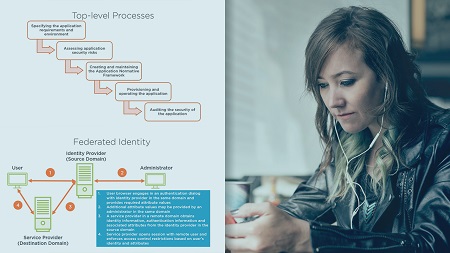
English | MP4 | AVC 1280×720 | AAC 44KHz 2ch | 2h 17m | 309 MB
Cloud Computing is changing industries and careers. This course will train you to design secure cloud applications, how to successfully migrate legacy applications to the cloud, and how to securely operate in the cloud computing environment.
Cloud computing has rocked every industry and has completely redefined enterprise information technology. Developers must now use DevSecOps, Serverless Computing, and Microservices to invent and deploy entirely new business models. In this course, Providing Secure Cloud Applications, you will learn how to do this in a secure manner. First, you will learn how to design a secure cloud application. Next, you will discover how to successfully migrate legacy applications to the cloud. Finally, you will explore how to securely operate in the cloud computing environment. When you have finished this course, you will be prepared to develop and deploy secure cloud applications that deliver true value to your organization.
Table of Contents
Course Overview
1 Course Overview
Training Developers for the Cloud
2 Course Introduction
3 Module Introduction
4 Loose Coupling
5 Base Transactionality
6 Cloud Development Basics
7 Microservices and Serverless Architectures
8 OWASP Top 10 Vulnerabilities
9 OWASP 2013 vs. 2017
Software Assurance and Validation
10 Module Introduction
11 Top-level Application Development Processes
12 Organizational Normative Framework
13 Provisioning and Operating the Application
14 Application Security Testing
15 Source Code Review
16 Cloud-based Functional Testing
Using Verified Secure Software
17 Module Introduction
18 US DHS Software Assurance Program
19 Application Programming Interfaces
20 Open Source Community Software
21 Software Supply Chain Management
Secure Software Implementation
22 Module Introduction
23 Secure Application Operations
24 Software Infrastructure Configuration Management and Versioning
Cloud Application Security Risks
25 Introduction
26 STRIDE Threat Model
27 Cloud Threats – Regulatory Non-compliance
28 Cloud Threats – Theft Loss of Media
29 Application QoS
Cloud Application Migration
30 Introduction
31 Application Assessment
32 Application Migration
33 Cryptography
34 VPN Protocols
35 Encrypting Data at Rest
Identity and Access Management Solutions
36 Module Introduction
37 Service Provider vs. Identity Provider
38 Multi-factor Authentication
39 Multi-factor Technologies
40 Single Sign-on
Auditing the Cloud
41 Module Introduction
42 Audit Objectives
43 Cloud Computing Audit Characteristics
44 Major Audit Types
Cloud Business Continuity and Disaster Recovery
45 Module Introduction
46 Disaster Recovery Planning Factors
47 Business Impact Assessment Report
48 Designing a Risk Management Strategy
49 Course Summary
Resolve the captcha to access the links!